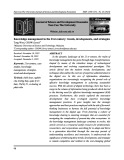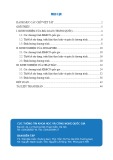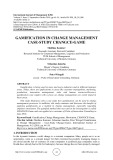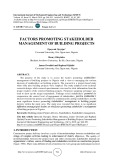
* Corresponding author
E-mail address:hengameh.hadian@gmail.com (H. Hadian)
© 2019 by the authors; licensee Growing Science, Canada
doi: 10.5267/j.uscm.2018.6.001
Uncertain Supply Chain Management 7 (2019) 17–32
Contents lists available at GrowingScience
Uncertain Supply Chain Management
homepage: www.GrowingScience.com/uscm
A multi-depot location routing problem to reduce the differences between the vehicles’ traveled
distances; a comparative study of heuristics
Hengameh Hadiana*, Amir-Mohammad Golmohammadib, Akbar Hemmatic and Omolbanin Mashkanid
aDepartment of Industrial Engineering, University of Nahavand, Nahavand, Iran
bDepartment of Industrial Engineering, Yazd University, Yazd, Iran
cDepartment of Industrial Engineering, K. N. Toosi University of Technology, Tehran, Iran,
dUniversity of Technology Sydney, Sydney, Australia
C H R O N I C L E A B S T R A C T
Article history:
Received February 2, 2018
Accepted June 7 2018
Available online
June 7 2018
This paper presents a model to solve the multi-objective location-routing problem with
capacitated vehicles. The main purposes of the model are to find the optimal number and
location of depots, the optimal number of vehicles, and the best allocation of customers to
distribution centers and to the vehicles. In addition, the model seeks to optimize vehicle routes
and sequence to serve the customers. The proposed model considers vehicles’ traveled
distances, service time and waiting time while guaranteeing that the sum of these parameters
is lower than a predetermined value. Two objective functions are investigated. First objective
function minimizes the total cost of the system and the second one minimizes the gap between
the vehicles’ traveled distances. To solve the problem, a Multi-Objective Imperialist
Competitive Algorithm (MOICA) is developed. The efficiency of the MOICA is demonstrated
via comparing with a famous meta-heuristics, named Non-Dominated Sorting Genetic
Algorithm-II (NSGA-II). Based on response surface methodology, for each algorithm, several
crossover and mutation strategies are adjusted. The results, in terms of two well-known
comparison metrics, indicate that the proposed MOICA outperforms NSGA-II especially in
large sized problems.
ensee Growin
g
Science, Canada
by
the authors; lic9© 201
Keywords:
Location routing problem (LRP)
Vehicle routing; Facility location
Imperialist competitive algorithm
(ICA)
NSGA-II
1. Introduction
In distribution network design, locating manufacturing facilities and planning distribution routes are
two critical issues which are usually tackled separately due to the complexity of the overall problem.
However, research has demonstrated that this strategy often leads to highly suboptimal solutions (Salhi
& Rand, 1989). The problem of location-routing overcomes this drawback via integrating the two
fundamental problems of facility locating and vehicle routing. This integrated approach has been found
to be useful and affordable in different real-life aspects. For example, the distribution of perishable
food products (Govindan et al., 2014), blood bank location (Or & Pierskalla, 1979), waste collection
(Caballero et al., 2007), parcel delivery (Wasner & Zäpfel, 2004), hub location and routing (Çetiner et
al., 2010), and mission planning in space exploration (Ahn et al., 2012).

18
The common objective for LRPs is to minimize the overall cost of the system. Despite the fact that
most real-world LRPs are characterized by more than one conflicting objective, a few papers
investigated the problem with different or multiple objective functions (Nagy & Salhi, 2007). Hence,
it is worth studying LRPs dealing with several monetary and non-monetary objective functions. In this
paper, a multi-objective LRP with capacitated and homogeneous vehicle fleet is modeled. The main
purposes of the model are to find the optimal number and location of depots, the optimal number of
vehicles, and the best allocation of customers to distribution centers and to the vehicles. Also, the model
tries to optimize vehicle routes and sequence to serve the customers considering their limited capacities.
The proposed LRP model deals with optimizing both monetary and non-monetary objective functions
at the same time. The monetary objective function seeks to minimize the total cost of the system
including the summation of fixed cost of open depots and transportation’s variable costs. The non-
monetary objective function minimizes the difference between vehicles’ traveled distances. This
objective function aims to provide a better trade-off between two problems of facility location and
vehicle routing problem. Hence, it is useful to find the optimum routes of vehicles and optimum
sequence to serve customers. The given problem is then solved by a new Multi-Objective Imperialist
Competitive Algorithm, called MOICA. The proposed meta-heuristic is compared with a well-known
evolutionary meta-heuristics, named NSGA II, in terms of two multi-objective comparison metrics for
numerous test problems.
The above mentioned properties along with the other classic constraints of the LRPs about distribution
centers and sub-tour elimination, and also considering some other graph based constraints form a
comprehensive modeling structure. Considering these assumptions and complexities simulatneously
make the problem more ralistic, and to the best of our knowledge, have never been discussed in the
related literature.
The remining of this paper is organized as follows: Section 2 discusses the contributions of the paper,
while in Section 3 problem definition and mathematical model are presented. Section 4 proposes
metaheuristics and solution approaches (i.e., MOICA and NSGA II) in addition to reporting parameter
setting, comparison metrics, generating numerical problems, and computational results. Finally,
conclusion and suggestion for further works are given in Section 5.
2. Contributions
2.1 Contributions in variants of LRPs
A survey on LRP literature revealed that the research on LRP is quite limited in comparison with
vehicle routing problem or location problem (Zarandi et al., 2011). The conceptual foundation of
researches on LRP dates back to 1960s (Boventer, 1961; Christofides & Eilon, 1969; Maranzana, 1964;
Watson-Gandy & Dohrn, 1973; Webb, 1968). The primary studies have identified the close interface
among location and transportation problems. However, these studies were far from capturing the total
complexity of the LRP. Salhi and Rand (1989) demonstrated that making separate decisions for location
and routing problems may lead to highly suboptimal solutions, even if the location decisions must be
made for a long term (Salhi & Nagy, 1999). During the past decades, several review papers have been
published on LRP literature (Balakrishnan et al., 1987; Min et al., 1998; Nagy & Salhi, 2007).
Furthermore, very recent surveys by Prodhon and Prins (2014) and Drexl and Schneider (2015)
represented a classification of LRP variants and discussed recent developments in the field. In this
paper, a novel model of multi-objective LRP is proposed paying more attention to the recent
developments.
2.2 Contributions in objective function
The common objective for LRPs is to minimize the total cost of the system. As it was mentioned before,
although most real-case LRPs are characterized by more than one conflicting objectives, just a few

H. Hadian et al. / Uncertain Supply Chain Management 7 (2019)
19
papers investigated a different objective or considered multiple objective LRPs (Nagy & Salhi, 2007).
However, some recent papers have dealt with several monetary and non-monetary objective functions
at the same time. Tavakkoli-Moghaddam et al. (2010) proposed an integrated mathematical model for
a bi-objective LRP with optional customers. The monetary objective is to minimize the total cost of the
system, while the non-monetary objective is to maximize the total customer demand served. The
authors applied two meta-heuristics to solve the problem, named Multi-Objective Scatter Search and
Elite TS (Gu et al., 2007). Wang et al. (2014) developed a nonlinear integer open LRP for relief
distribution problem where optimization of the total cost, travel time, and reliability with split delivery
are considered simultaneously. The authors used the non-dominated sorting genetic algorithm and non-
dominated sorting differential evolution algorithm to solve the problem. Martínez-Salazar et al. (2014)
proposed a non-linear bi-objective two echelon LRP with several capacitated facilities and fixed
opening costs on both levels. The first objective is to minimize the total distribution cost and the second
is to balance route duration. The authors offered two meta-heuristic solution algorithms: a scatter tabu
search procedure and a Non-dominated Sorting GAII (NSGA-II).
In this paper, the proposed LRP model copes with optimizing two monetary and non-monetary
objective functions. The monetary objective function is to minimize the total cost of the system and is
defined as a summation of fixed cost of open depots and the transportation’s variable costs. The non-
monetary objective function is to minimize the differences between vehicles’ traveled distances to
provide a better trade-off between two problems of facility location and vehicle routing problems.
Consequently, the non-monetary objective function is useful to find the optimum routes of vehicles and
optimum sequence to serve customers. To the best of our knowledge, investigating all abovementioned
goals is unique in the literature and can be considered as an important contribution of the paper.
2.3 Contributions in solution approaches and meta-heuristics
The LRPs combine two essential sub-problems of location-allocation and vehicle routing problems.
Since both of these problems are NP-hard (Megiddo & Supowit, 1984; Salhi & Nagy, 1999), obviously
the location-routing problem is also NP-hard. In such complicated combinatorial problems, exact
solutions and optimization solvers such as LINGO, GAMS and CPLEX are inefficient, especially on
large-sized problems (Diabat, 2014; Roozbeh Nia et al., 2015). Hence, to solve the large size instances
of the problem, meta-heuristic search algorithms are needed to obtain near optimal solutions in
acceptable computing time. Many studies have successfully employed several meta-heuristic
approaches to solve various optimization models of LRP. Some of these meta-heuristic algorithms are:
scatter search (Tavakkoli-Moghaddam et al., 2010), simulating annealing (Mohammadkhanloo &
Bashiri, 2013; Yu & Lin, 2015), tabu search (Fakhrzada & Esfahanib, 2013; Goścień et al., 2015),
particle swarm optimization (Marinakis et al., 2013; Norouzi et al., 2015), genetic algorithm (Karakatič
& Podgorelec, 2015; Setak et al., 2014), evolutionary algorithm (Koç et al., 2015; Prodhon, 2011),
neural networks (Kopfer et al., 2005; Schwardt & Fischer, 2008) and ant colony optimization (Sim &
Sun, 2003; Ting & Chen, 2013). Among these approaches, the population-based algorithms are usually
preferred to others and in most cases show better performances (Roozbeh Nia et al., 2015).
An evolutionary algorithm inspired by imperialist competition process, named Imperialist Competitive
Algorithm (ICA), was introduced by Atashpaz-Gargari & Lucas (2007). This evolutionary algorithm
shows some attractive features to be employed in solving LRPs. As the most important feature, ICA
searching process is designed well. The probability of falling into the trap of local optima, especially
in problems with very large search spaces, is efficiently reduced using different well-designed operators
such as relocation of solutions in the search space frequently (Jula et al., 2015). In addition, the ICA
provides extensive areas of innovation because it is younger than most proposed evolutionary
algorithms (Jula et al., 2015). It should be noted that the ICA has presented better performance
compared with most population based algorithms in terms of both the objective function values and
computational time (Roozbeh Nia et al., 2015). Shiripour et al. (2012) proposed two meta-heuristics,

20
namely GA and ICA, to solve a multi-facility location problem. They showed that the proposed ICA
has better performance from both the computing time and solution accuracy point of views in
comparison with GA. Mohammadi-Ivatloo et al. (2012) used ICA for solving non-convex dynamic
economic power dispatch problem. The authors compared the results of this algorithm with those of
particle swarm optimization (PSO) and the best known genetic algorithm (GA), and as a consequence
the ICA has more efficient results. In this paper, a novel meta-heuristic algorithm, which is called
Multi-Objective Imperialist Competitive Algorithm (MOICA), is developed to solve the problem
exploiting the ICA properties.
3. Problem definition and assumption
3.1 Notations
The sets, parameters, and decision variables, which are used in this research, are introduced in following
sub-sections.
3.2 Sets
I Set of potential depot locations iϵ{1,…, m} ,
J Set of customers jϵ{1, … ,n},
K Set of transportation vehicles kϵ{1, … ,k},
3.3 Model Parameters
n Number of customers
P Number of depot locations
K Number of available vehicles
tij Traveling time from point i to point (i, j
∈
I
∪
J)
Fi The fixed cost of opening a depot at site i
Cij The unit cost of transportation from point i to point j (i, j
∈
I
∪
J)
dij Distance among point i and point j (i, j
∈
I
∪
J)
FVk The fixed cost of transportation by vehicle k
Dj The demand of costumer j
Sjk Service time of vehicle k in place of costumer j
Wjk Waiting time of vehicle k in place of costumer j
DI Imbalance between distances traveled by vehicles
Q Fixed loading capacity of transportation vehicles
3.4 Decision Variables
Xijk It is equal to 1, if point j is immediately met after point i by vehicle k (i, j
∈
I
∪
J, k
∈
K); 0
otherwise.
Yi Equal to 1, if depot is located at site i; 0 otherwise.
Zij Equal to 1, if customer j is served by depot i; 0 otherwise.
Uik Auxiliary variables used in sub-tour elimination.
3.5 The Mathematical Model
In this section, a mathematical model of multi-objective LRP with capacitated vehicles is proposed. To
formulate the problem, let G= (V, E) be an undirected simple graph where V is a set of nodes comprised
of a subset I of P potential depot locations and a subset J=V/I of n customers. Furthermore, the arc set
E includes the pairs e= (i, j), where each depot site i ϵ I has a fixed opening cost, and each customer j
ϵ J has a demand that must be fulfilled by a single vehicle. The unit cost of transportation is determined.
A set K of homogeneous vehicles with limited capacity is available. Each vehicle incurs a dependent
cost when used by a depot i and also navigates a single route. Each route must begin from and terminates

H. Hadian et al. / Uncertain Supply Chain Management 7 (2019)
21
at the same depot, while its total load must not exceed vehicle capacity, and no route is considered
between depots. In addition, the sum of vehicles’ traveling time, service time (Sjk,) and waiting time
(Wjk) must be lower than a predetermined value of B.
min i i k ijk ij ij ijk
iI kK iI jJ iI jJkK
F
yFV x CdX
(1)
min max( ) min( )
ij ijk ij ijk
iI jJ iI jJ
DI d X d X
kK
(2)
subject to:
ii
iI
yP
(3)
1
ijk
kKiI J
x
j
J
(4)
0
ijk jik
jI J jI J
xx
,kK
iI J
(5)
1
ijk
iI jJ
x
kK
(6)
jijk
jJ iI J
DxQ
kK
(7)
()1
ij iuk ujk
uI J
zxx
,kK
iI
j
J
(8)
()
ij ijk
iI JjI J
jk jk ijk
jJ jI J
tx
Sw x B
kK
(9)
ij i
zy ,iIjJ
(10)
1
gk jk gjk
UU Nx N
,,
g
jJ
kK
(11)
,, {0,1}
ijk i ij
xyz ,,ij I J
kK
(12)
0
lk
U ,lIkK
(13)
The objective function Eq. (1) seeks to minimize the total cost of the system consisting of depot opening
cost, and fixed and variable transportation costs. The objective function (2) seeks to minimize the value
of DI, in order to reduce the difference between distances traveled by vehicles. This objective function
is useful to find the optimum routes of vehicles and optimum sequence to serve customers as well as
having a better trade-off between two problems of facility location and vehicle routing problem.
Constraint (3) ensures that the number of depot locations is equal to a predetermined value. Eq. (4)
ensures that each customer is allocated to a single opened depot and be served using only one
transportation vehicle. Constraint (5) gives a guarantee in that each route must begin from and end at
the same depot. This means that a given vehicle departed a customer that it had served. The set of Eq.
(6) ensures that there can be a maximum of one rout between two costumers. Constraint (7) is used to
limit the capacity of vehicles. The set of Constraint (8) states that the demand can be assigned to the
customers only in a route including both of depot and customers. Constraint (9) guarantees that the
vehicles’ total traveling time, service time and waiting time must be lower than a given amount of B.
The set of Constraint (10) ensures that a depot can serve the customers when it is established and
Constraint (11) guarantees the sub-tour elimination. Finally, the set of Constraints (12) to (13) are used
to represent the nature of the decision variables.


























